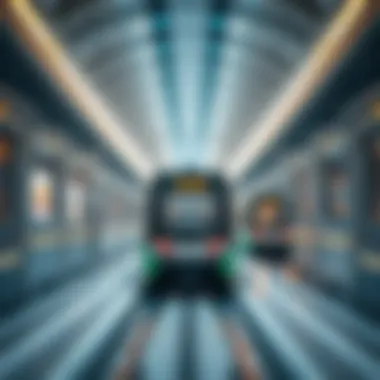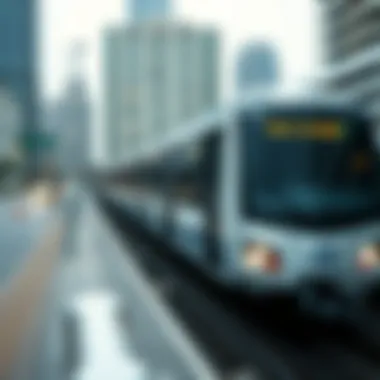Examining the Metro Dubai Plan: A Vision for Urban Mobility


Intro
The urban landscape of Dubai has undergone substantial evolution over the years, where the integration of various transport systems has been crucial in managing its rapid growth. The Metro Dubai Plan stands out as a core feature in this narrative, not merely as a transit solution but as a catalyst for broader urban development. This initiative is not just about getting from point A to point B; rather, it aims to redefine how the city's inhabitants and visitors experience mobility in a bustling metropolis.
As Dubai faces the pressures of population increase and economic activity, a well-thought-out transportation system becomes integral to its future. The Metro addresses the pressing issues associated with urban congestion, environmental sustainability, and overall quality of life.
By delving into the specifics of the Metro Dubai Plan, we can uncover its multifaceted advantages. From its design and operational efficiency to the socio-economic impacts it brings to residential and commercial sectors, each layer reveals valuable insights for investors, real estate professionals, and policymakers alike. This article seeks to weave these threads into a coherent narrative and highlight how the Metro serves as a backbone for the city's aspirations and its citizens’ daily lives.
Overview of the Metro Dubai Plan
The Metro Dubai Plan stands as a cornerstone in Dubai's endeavor to create a comprehensive and sophisticated urban transport system. As a city that experiences exponential growth and rising population numbers, the need for an efficient and reliable transportation network cannot be overstated. The Metro is designed not just to provide a means of travel, but to fundamentally reshape the urban landscape, enhance connectivity, and promote sustainable growth.
In recent years, urbanization has transformed cities globally, and Dubai is no exception. The Metro serves as a response to the city's pressing issues like traffic congestion, pollution, and the demand for rapid transport solutions. It's more than a public transit system; it acts as a catalyst for socioeconomic development, encouraging investment and altering the way inhabitants interact with their urban environment.
Historical Context
The historical context of the Metro Dubai Plan is essential to understand the motivations and planning that have shaped it. Originally conceived in the early 2000s, the project emerged from a vision to modernize Dubai's infrastructure in line with its rapid development. Launched in 2009, the Metro was notable for being one of the first fully automated metro systems in the world. This aspect not only highlights Dubai’s forward-thinking approach but also its ambition to be at the forefront of global urban development.
Dubai's swift economic expansion, driven by tourism and business, created an urgent need for a robust public transport system. Additionally, the government recognized that, for the city to be sustainable, reliance on cars must be curtailed. Thus, the Metro was designed to be a game changer in urban commuting, offering an efficient alternative to personal vehicles.
Objectives of the Metro Plan
The objectives of the Metro Plan are multifaceted, aiming to address various urban challenges while enhancing the city's appeal as a global hub. One primary goal is to improve public transit accessibility for residents and visitors alike. By integrating different transport modes, the Metro seeks to provide seamless connectivity across the city, reducing travel times and encouraging the use of public transport.
Moreover, the Metro aims to lessen the environmental impact associated with traffic congestion. By encouraging individuals to shift from private cars to public transport, it intends to reduce greenhouse gas emissions and promote cleaner air quality. This aligns with Dubai's broader sustainability goals and its commitment to environmental stewardship.
In a nutshell, the Metro Dubai Plan serves not only as an infrastructural achievement but as an integral piece of Dubai's urban puzzle, contributing to the efficient mobility of people and goods, while also addressing the city's long-term vision for sustainable and livable urban environments.
The Metro Dubai Plan exemplifies how infrastructure can shape future urban living, highlighting the intertwining of travel, environment, and economic potential.
Key Features of Metro Dubai
The Metro Dubai system stands as a beacon of modern transport infrastructure, paving the way for more effective urban mobility in one of the fastest-growing cities on the planet. Each feature of the Metro is designed not only to alleviate existing transportation woes but also to provide a forward-thinking approach to the future of urban transit. This section delves into the essential characteristics that make the Metro Dubai system a cornerstone of the city’s transport strategy.
Rail Network Design
The design of the rail network is a primary consideration when discussing the Metro's success. Covering several key zones throughout Dubai, it operates on a dual-line system comprising the Red Line and the Green Line. This dual connectivity enhances access from the bustling heart of the city to more suburban locales.
Key aspects of the rail network include:
- Station spacing optimized for urban density, ensuring that no area is too far from a station. This thoughtful planning encourages ridership by making public transport convenient.
- Elevated and underground sections provide minimal disruption to city life while accommodating Dubai's unique topography and architectural ambitions.
- Expansion plans ongoing as the metro lines are continuously evaluated for new additions, demonstrating adaptability to the city's growing population.
This design is essential for integrating public transport into daily life. The metro effectively reshapes commuting patterns, making it not only a method of transport but a part of everyday routines for residents and visitors alike.
Stations and Accessibility
Accessibility is another critical feature of the Metro Dubai plan. The stations are characterized by their modern design and the inclusion of facilities that cater to a diverse ridership. Each station features:
- User-friendly design, with ramps, elevators, and well-marked pathways intended to assist individuals of all abilities.
- Proximity to major landmarks, such as shopping malls, business zones, and tourist attractions, which further facilitates travel. This strategic planning encourages greater use of the metro rather than personal vehicles, ultimately reducing road congestion.
- Amenities, including waiting areas, retail outlets, and information kiosks, enhancing user comfort and overall experience while waiting.
Accessibility is not just about physical reach; it also incorporates user experience. Metro Dubai's commitment to ensuring every community can partake in its benefits is evident in both the frequency of service and the ease of station layouts.
Technology Integration
Tech integration is perhaps where the Metro Dubai plan shines brightest. Adopting cutting-edge technologies ensures the system runs efficiently and meets contemporary user expectations. Some noteworthy technological features include:
- Smart ticketing systems, allowing users to pay fare using NFC-enabled devices or recharge their Nol cards via mobile apps. This convenience can’t be overstated, particularly in a city where time is often of the essence.
- Real-time tracking and information systems, available through mobile applications and at station displays, keep commuters informed about train schedules, delays, and other important announcements.
- Energy-efficient trains, designed for lower carbon emissions, reflect Dubai’s sustainability efforts while also enhancing the overall performance of the Metro.
Incorporating state-of-the-art technology transforms the travel experience, moving it into the realm of smart transport solutions. Passengers today expect more than just functionality; they look for an experience that is seamless and advanced, which is crucial for a city as dynamic as Dubai.
For more detailed insights into the Metro Dubai features, visit Wikipedia - Dubai Metro.
Operational Efficiency of Metro Services
Operational efficiency is a cornerstone of any successful public transport system, and the Metro Dubai services shine in this regard. This efficiency shapes the entire experience for users, addressing traffic woes, reducing wait times, and ultimately enhancing urban mobility within this bustling metropolis. Evaluating the operational efficiency of Metro services involves exploring two critical elements: service frequency and reliability, as well as the fare system and payment methods.
Service Frequency and Reliability
In a vibrant city like Dubai, the frequency of metro services directly impacts commuter convenience and satisfaction. The Metro’s design allows for a smooth service cadence, with trains running at intervals that cater to the peak hour rush as well as quieter periods. For instance, during rush hour, one can expect a train every two to three minutes, while off-peak times still offer commendable frequency that keeps the wheels of urban life turning smoothly.
Moreover, reliability is crucial. An efficient metro service needs to be consistent, with minimal breakdowns or delays. The integration of advanced signaling and monitoring technology allows for real-time tracking and swift resolution of any issues. You know how frustrating it is to wait for a train that’s running late; the Metro Dubai aims to keep those moments to a bare minimum. They employ a robust control center that monitors every aspect of the train operations, ensuring any hiccup is dealt with swiftly. In this sense, Dubai's Metro system captures the essence of public transport by providing a punctual service that commuters can trust.
"A transport system thrives on the trust of its users; keeping trains on time is half the battle won."
Fare System and Payment Methods
Navigating a city shouldn’t involve wrestling with complicated fare systems, and Dubai's Metro gets this. The fare structure is designed to be straightforward, appealing to both residents and visitors. The use of distance-based pricing means that the fare increases with the distance traveled, making it fair for everyone using the service, whether they are commuting a short trip across one or two stops or traversing longer routes.
Payment methods also play a significant role in operational efficiency. The introduction of the Nol card system simplifies payment processes, allowing for seamless access across all public transport, including buses and water taxis. These cards can be topped up online, at kiosks, or even via mobile apps, saving time and ensuring hassle-free travel.
Furthermore, the acceptance of contactless payment options adds a layer of convenience that resonates well with the tech-savvy urban dwellers. No need to fumble for change or worry about exact fare amounts. With a tap, you’re ready to roll.
In essence, the operational efficiency of Metro Dubai services is not just about smooth rides; it encompasses a comprehensive user-friendly approach. With reliable service frequency and a modern fare system that eases the travel burden, this Metro stands at the forefront of urban transportation, aligning perfectly with Dubai’s vision of an integrated, efficient, and sustainable city.


For further insight into public transportation dynamics, you might want to explore Britannica's overview on transportation systems.
Impact on Urban Mobility
The Metro Dubai Plan is not just about trains running from point A to B; it’s a tapestry woven into the very fabric of Dubai’s urban landscape. Creating an effective transport network turns out to be a linchpin for a city like Dubai, where population growth and economic momentum demand seamless movement. Let’s dive into the nitty-gritty of how this plan significantly impacts urban mobility.
Reduction of Traffic Congestion
One of the most pressing issues in metropolitan areas is traffic congestion. In Dubai, the confluence of rapid urban growth and increasing vehicular traffic made congestion a growing concern. The Metro Dubai Plan aims to tackle this issue head-on. By providing a reliable and efficient alternative to cars, the metro system plays a pivotal role in mitigating the infamous bottlenecks that plague the city’s roads.
- Shifting Mindsets: The more people use the metro, the fewer vehicles are crowding the streets. This shift is crucial in easing congestion during peak hours, typically seen in business hubs like Sheikh Zayed Road and the Marina District.
- Smart Scheduling: With trains running at frequent intervals, it ensures that people are not left waiting for ages, ultimately incentivizing commuters to ditch their cars in favor of trains.
- Environmental Relief: Less traffic on the roads also translates to lower emissions, contributing to cleaner, fresher air that residents can actually breathe.
As a result, the Metro not only alleviates immediate congestion but paves the way for long-term urban planning strategies. Plans are underway to expand the metro while integrating it with other modalities like buses, taxis, and bicycles, ensuring a comprehensive transport network.
"The rapid expansion of public transport, like the Metro Dubai, is vital in sustaining urban mobility and ensuring a livable city for all."
Promotion of Public Transportation Use
Public transportation is often seen as an underrated option, but the Metro Dubai Plan has been instrumental in changing perceptions.
- Accessibility and Convenience: With strategically placed stations across key areas, people find it easier to hop on a train than navigate through traffic. This accessibility encourages even the most skeptical drivers to consider public transport as a viable option.
- Affordability: Fare systems are designed to be competitive. When compared to the costs associated with car ownership, parking, fuel, and maintenance, the metro stands out as a cost-effective alternative.
- Community Awareness: The metro system fosters community through public campaigns aimed at encouraging people to use public transport. Events that promote car-free days or discounts during off-peak hours help to cultivate a transportation culture that looks beyond personal vehicles.
The promotion isn't solely about garnering more riders; it’s about shifting societal norms. By normalizing the use of public transit, the Metro Dubai ensures that commuting is viewed as a shared experience rather than an individualized one. This shared culture not only fosters community spirit but also reduces the carbon footprint, contributing to a sustainable Dubai.
In summary, the Metro Dubai Plan serves a critical role in defining urban mobility. Through the reduction of traffic congestion and the promotion of public transportation use, it creates a more efficient, greener, and interconnected city.
Sustainability Initiatives
The sustainability initiatives in the Metro Dubai Plan are at the heart of the city’s aspirations for environmentally responsible urban growth. As Dubai continues to evolve into a bustling metropolis, the focus on sustainability becomes critical, not just for meeting current demands but also for preparing future generations. Sustainability serves as a framework through which the Metro system can minimize its environmental footprint, promote better resource management, and foster a culture of ecological awareness among its users.
Environmental Considerations
When it comes to the environmental aspects of the Metro Dubai system, several strategies are in place to mitigate impact on nature. First and foremost, the use of electric trains helps reduce greenhouse gas emissions significantly compared to traditional diesel-powered systems. The introduction of state-of-the-art engineering practices also plays a vital role in maintaining the delicate equilibrium in the natural habitat around the metro lines.
Key components to consider include:
- Wildlife Protection: The construction of designated wildlife corridors facilitates migration and reduces human-wildlife conflicts.
- Noise Pollution Management: Sound barriers and strategic design approaches help lessen noise impact on surrounding communities.
- Water Conservation Efforts: Rainwater harvesting systems and efficient drainage mechanisms have also been installed to ensure optimal water use.
"Sustainable Metro systems are not merely about moving people; they embody a vision for a greener and cleaner urban future."
Energy Efficiency Measures
Energy efficiency measures are interwoven into the operational strategy of the Metro Dubai Plan. These efforts go beyond the use of electric trains; they encompass various technological and infrastructural innovations aimed at minimizing energy consumption and maximizing efficiency throughout the system.
- Regenerative Braking Systems: Trains are equipped with regenerative braking technology that captures kinetic energy during stops and redirects it back into the power grid, creating a significant reduction in overall energy demand.
- LED Lighting: The installation of energy-efficient LED lighting in stations and trains cuts down on electricity usage and enhances visibility without compromising safety or aesthetics.
- Smart Energy Monitoring: By integrating IoT devices, the system allows for constant monitoring of energy consumption patterns, leading to data-driven decisions that optimize energy efficiency in real time.
As the Metro system expands, sustaining these energy-efficient methods will be key to achieving long-term goals. Investors, expats, agents, managers, and buyers can take solace in knowing Dubai is committed to best practices, signaling a progressive vision for urban development that simultaneously nurtures the environment.
Future Expansion Plans
The notion of future expansion plans holds significant weight in the scope of the Metro Dubai initiative, as it is a key driver of continual urban development and enhanced connectivity within this thriving metropolis. Investors, expats, and urban planners alike find the following aspects particularly relevant. Future expansions not only aim to increase the reach of the metro system but also align with broader urban development goals, fostering sustainable urban living while accommodating the growing population.
Upcoming Lines and Extensions
Future enhancements to the Metro Dubai may include several incoming lines and extensions, each intended to address specific transport needs while facilitating increased access to various districts. Notably, plans exist to add new lines that will connect to emerging urban developments and business hubs. For instance:
- The Purple Line is anticipated to connect central Dubai with the bustling areas of Dubai Marina and Jumeirah, facilitating greater tourist access.
- The Blue Line, drawing from community feedback, aims to link underserved areas with the core of the city, enhancing inclusivity in urban mobility.
Each proposed line is carefully designed to eliminate bottlenecks, cutting down overall travel time while encouraging more residents to opt for public transportation over private vehicles. As an example, the strategic placement of new stations will effectively serve high-density residential zones, creating a streamline in the daily commute.
Projected Growth and Infrastructure Needs
Given the ambitious vision of the Metro plan, projecting growth and understanding infrastructural needs is paramount. Operators expect a significant increase in ridership levels as new lines roll out, with projections estimating a rise by approximately 30% over the next decade.
This anticipated growth raises several key considerations:
- Infrastructure Investment: Ensuring that adequate funding is allocated for necessary upgrades to current systems, including signaling technology and station enhancements, remains crucial.
- Capacity Planning: With a growing user base, trains and stations must be equipped to handle increased foot traffic to prevent overcrowding. This leads efficiently to enhanced customer experience and assurance of safety standards.
- Community Engagement: Engaging with local communities during planning phases to address their needs and gather input can create better-designed spaces that serve their interests.
Overall, as the Metro Dubai Plan unfolds its future expansion strategy, the implications for urban connectivity and strategic urban planning continue to bear substantial importance. Greater efficiency in transit systems will play a pivotal role in shaping the future urban landscape of Dubai.
"A well-planned transport layer integrates seamlessly into the urban fabric, streamlining mobility for residents and tourists alike through foresight and innovative solutions."
For further resources and insights on related urban transport planning, consider exploring: Wikipedia - Metro Systems, Britannica - Urban Planning or engage with community discussions over at Reddit - Urban Planning.
Socio-Economic Implications
The Metro Dubai Plan is not just a transport initiative; it plays a crucial role in shaping the socio-economic landscape of Dubai. As the city strides ahead in its ambitions, the integration of the Metro system is essential for realizing broader urban development goals. It not only enhances transportation efficiency but also catalyzes economic growth, influencing property markets and community connectivity.
Impact on Real Estate Values
Investors and stakeholders in the real estate sector keenly observe the ripple effects the Metro system creates. A direct correlation often exists between the proximity of properties to Metro stations and their market value. Properties within easy reach of the Metro tend to command higher prices due to their appeal to both buyers and renters seeking convenience. The accessibility offered by the Metro enhances the desirability of neighborhoods that might have otherwise been overlooked.
- Enhanced Demand: Areas adjacent to Metro lines typically experience increased demand, leading to a surge in property values.
- Development Opportunities: Developers are more likely to invest in areas with Metro accessibility, prompting a wave of new residential and commercial projects.
- Long-term Investments: For investors, properties near the Metro represent long-term value, as developments often outpace those in less accessible areas.
As this connectivity is established, the Metro does not just change landscape; it alters the economic fabric of these communities.


Enhancing Community Connectivity
Beyond the figures of real estate, the Metro system has an immense impact on community life. By bridging gaps between various neighborhoods, it fosters a sense of belonging and encourages social interaction among residents. The importance of community connectivity cannot be overstated in a metropolis like Dubai, where diverse cultures converge.
- Accessibility for All: The Metro promotes inclusivity, allowing all segments of society to access key areas such as workplaces, schools, and leisure spots.
- Improved Quality of Life: With reduced travel time, residents find more opportunities to engage in community activities, leading to vibrant social engagements.
- Economic Equitability: Areas that were previously disconnected can now thrive economically, as residents have easier access to employment and services.
"The Metro is not just a line on a map, it's a lifeline that stitches our diverse community together."
By facilitating mobility, the Metro contributes to nurturing a more integrated and cohesive community, ultimately enhancing the overall socio-economic landscape of Dubai.
Challenges and Criticisms
Examining the challenges and criticisms of the Metro Dubai Plan is essential for understanding its overall effectiveness and sustainability. With ambitious urban development goals, the project is not without its hurdles. Addressing these elements provides insight not only into the operational difficulties but also into how public sentiment can influence transportation projects in a rapidly evolving city like Dubai.
Construction and Operational Challenges
Building a metro system in a bustling metropolis presents a unique set of construction and operational challenges. The Metro Dubai faces the dual task of integrating seamlessly into an already developed urban landscape while adhering to strict timelines and budgets. Factors such as excavation complications, particularly in an area with a high water table, can delay construction.
Moreover, labor issues can arise, including labor disputes, which may impact project timelines. For those in the service and investment sectors, these delays can translate into financial implications, and often lead to increased project costs. Reliable contractor performance is crucial, and any inconsistency can further complicate already tight schedules.
Another layer of complexity comes from the necessity to maintain current traffic flows during construction. The disruption caused to existing transport methods can frustrate commuters and increase reliance on other modes of transport, contributing to traffic congestion. Addressing these challenges through effective planning and management strategies can greatly reduce their impact.
Public Perception and Satisfaction
Public perception of the Metro Dubai is as much a factor in its success as its infrastructure. The perception among residents and future expats can dictate the popularity and usage of the system. Many see it as a sign of progress and modernization, while others have voiced concerns over its reliability and safety. Frequent updates to the metro system, including technological advancements and station accessibility improvements, are vital for enhancing user satisfaction.
Furthermore, community engagement plays a pivotal role in shaping public sentiment. When residents have the opportunity to voice their opinions, it can create a sense of ownership, thereby fostering support for the project. However, neglecting public concerns can result in backlash, ultimately undermining the benefits that the Metro aims to achieve for urban mobility.
To this end, a comprehensive feedback system that captures user experiences can help understand satisfaction levels effectively. Addressing issues promptly and incorporating feedback into continuous improvement plans can elevate the Metro’s status in the eyes of the public.
"Public perception is a mirror reflecting the effectiveness of our initiatives. Satisfaction fuels support, and neglect turns it sour."
Comparative Analysis with Global Metro Systems
In the ever-evolving landscape of urban transport, it’s imperative to keep an eye on how different cities tackle their own public transportation hurdles. By conducting a comparative analysis with global metro systems, this section sheds light on the Metro Dubai Plan's uniqueness while drawing parallels with other successful models such as the London Underground, New York City Subway, and Tokyo Metro. These systems offer valuable insights that can guide future enhancements of Dubai's metro framework.
Lessons from Other Cities
Examining global metro systems reveals key takeaways that can benefit the Metro Dubai Plan:
- Integration of Transportation Options: Cities like Tokyo successfully integrate rail, bus, and even bicycle-sharing systems. A seamless connection between various transport modes increases usability. Achieving this in Dubai would further enhance user experience.
- User-Centric Design: The New York City Subway provides an excellent example of prioritizing user experience. Stations are designed with multilingual signage and digital información displays. This could be especially beneficial in Dubai, given its diverse population.
- Sustainability Focus: Metro systems in cities such as Copenhagen focus heavily on sustainability tactics. Renewable energy sources and green building practices reduce environmental impact. Emulating such practices could enhance Dubai's commitment to sustainability.
- Real-Time Data Utilization: London’s Tube leverages real-time data to keep commuters informed about delays and service changes. Implementing similar systems in Dubai would enhance transparency and trust in the metro’s reliability.
By considering these lessons, Dubai can fortify its metro plan and ensure it not only competes on a global scale but also sets a benchmark for emerging cities.
As we dive deeper into understanding the Metro Dubai Plan, remember that collaboration with world-class metro projects can foster growth that lifts community spirits and enhances overall urban living.
“In any urban transit development, learning from the best can shape not just infrastructure but also the very fabric of a city’s daily life.”
The implications of such comparative insights can resonate with investors, developers, and urban planners, ultimately paving a smoother path toward achieving the Metro Dubai vision.
The Role of Metro Dubai in Urban Planning
The integration of the Metro Dubai into the urban planning narrative of the city is crucial. It transcends mere transportation solutions—it embodies a comprehensive approach to urban growth and sustainable development. By weaving a network of efficiency, accessibility, and community engagement, the metro system looks to shape the very fabric of Dubai's urban environment.
Firstly, the Metro serves as a vital component in addressing the challenges posed by rapid urbanization. Given Dubai's accelerated growth rate, the necessity of a reliable transit system has never been more pronounced. Without it, the burgeoning population would continue to face unsustainable congestion and environmental pressures. Leveraging the metro not only facilitates day-to-day commutes but also reduces reliance on personal vehicles, thereby diminishing traffic congestion and lowering emissions.
Important elements of this integration include:
- Strategic Planning: Metro lines have been designed to connect key residential areas with commercial districts, optimizing travel routes for workers and residents alike.
- Enhanced Accessibility: Stations are strategically located near places of interest, such as malls, hospitals, and cultural landmarks, ensuring that all citizens have easy access to essential services.
- Sustainable Development: The planning phase takes environmental sustainability into account, encouraging the development of green spaces adjacent to stations and promoting eco-friendly buildings.
In addition to facilitating movement, the Metro Dubai system indirectly benefits the local economy. A well-connected transit network enhances property values, particularly for developments near metro stations. Investors and homeowners alike recognize the attractiveness of living in proximity to efficient transportation, which leads to increased demand.
Furthermore, the interaction between the Metro and other transportation modes is paramount. Whether it is taxis, buses, or ride-sharing services, the seamless connection among these services amplifies convenience. Riders can easily transfer from one mode to another, creating a comprehensive system that caters to the dynamic needs of the populace.
“Urban mobility is not just about transit systems; it’s about redefining the relationship between people and their city.”
Integration with Other Transportation Modes
Merging the Metro Dubai with other transportation systems has been approached with meticulous thought. The vision here is clear: a holistic transportation ecosystem that caters to each individual's travel requirements. Some aspects to consider include:
- Transport Hubs: These centers provide facilities that allow for smooth transitions between the Metro and other forms of transportation.
- Real-Time Information: Riders can access digital platforms offering updates on schedules and connections, minimizing wait times.
- Unified Payment Methods: One card can facilitate travel across multiple modes, reinforcing ease of use and enhancing rider satisfaction.
Overall, this integrated approach conveys a strategic ambition to create not just a transport network, but a framework that encourages community interaction and economic growth. As the partners in these transport avenues work in harmony, a well-functioning transportation system slowly becomes the heartbeat of Dubai, pulsing with the life of its diverse inhabitants.
User Experience and Accessibility
User experience and accessibility lie at the heart of the Metro Dubai Plan. A well-considered transport system must not only deliver functionality but also enhance the comfort of its users. Given Dubai’s status as a melting pot of cultures and communities, ensuring that the Metro meets diverse needs is essential. A positive user experience contributes to higher ridership, reduced reliance on personal vehicles, and promotes a sense of belonging among residents and visitors.
Comfort and Safety Standards
When it comes to metro travel, comfort is a non-negotiable aspect. Metro Dubai prioritizes user comfort through various design decisions. For instance, the air conditioning systems are designed to keep trains and stations cool even during harsh summer heat. Soft seating in trains allows for a relaxed journey, while spacious interiors cater to varying passenger loads during peak hours.
Additionally, safety standards are also at the forefront. The trains are equipped with advanced braking systems to ensure timely stoppages, and staff are trained to handle emergencies effectively. There are also numerous CCTV cameras installed throughout stations and trains, ensuring that passengers can travel with peace of mind. These elements combine to create an inviting atmosphere that encourages people to choose public transport over their cars.
"A great transport system doesn’t just take you from point A to B; it ensures that the journey itself is worthwhile."


Facilities for Special Needs
Inclusive design is a cornerstone of the Metro Dubai Plan. Facilities for special needs individuals are integrated throughout the system. Stations feature ramps and elevators, ensuring accessibility for those with mobility impairments. Audio and visual announcements guide passengers with hearing and sight challenges, ensuring they feel secure navigating the system.
Metro Dubai also provides priority seating clearly marked for the elderly and people with disabilities, and personnel are trained to assist any passenger who might need help. Temporary barriers, tactile paving, and clear signage are key features that contribute to easy navigation within the station environment. By anticipating various needs, Metro Dubai underscores its commitment to creating a transport network that values every individual's right to access.
In summary, the focus on user experience and accessibility not only promotes inclusivity but also significantly enhances the reputation of Metro Dubai as a forward-thinking urban transit system. This approach not only supports practical mobility but also enriches community life, resonating with the ethos of a vibrant, progressive city.
Impact Assessment and Future Research
The Metro Dubai Plan is more than just a transportation initiative; it symbolizes the vision of a future-driven urban landscape. The importance of impact assessment and future research in this context cannot be overstated. It involves evaluating the operational and social outcomes of the Metro system, ensuring that it not only meets present requirements but also addresses future challenges and expectations.
With the rapid evolution of city dynamics, continuous assessment is key. Through rigorous analysis, stakeholders can understand how well the Metro aligns with the wider urban development goals. This assessment highlights areas of success, revealing what moves the needle in this vibrant metropolis, and identifies possible pitfalls that require attention.
Benefits of Impact Assessment
- Enhancing User Experience: By gauging user satisfaction and operational effectiveness, the Metro authorities can implement changes that enhance comfort and convenience. A sound understanding of passenger needs can lead to significant improvements in service quality.
- Sustainable Development: Assessing environmental impacts ensures the Metro's contributions to sustainability are maximized. By focusing on sustainable practices, such as energy-efficient operations and minimal environmental footprints, the Metro reinforces Dubai’s commitment to a greener future.
- Informing Future Projects: Impact assessments provide a blueprint for future expansions and enhancements. Understanding what has worked — and what hasn’t — allows for smarter planning and resource allocation in future undertakings.
Considerations for Future Research
Future research should focus on a variety of topics, aiming to refine operations and explore innovative integrations within urban transport systems. Some elements to consider include:
- Regional Connectivity: Examine how the Metro can interface more effectively with other transport modalities, such as buses and rideshares, thereby improving overall mobility.
- Technological Advancements: Investigate potential technological integrations, such as AI for operational efficiency or real-time data analytics for route optimizations.
- Socio-Economic Analysis: Conduct studies on the socio-economic benefits brought about by increased accessibility and the resulting effect on local businesses and real estate markets.
In essence, continuous evaluation and research are vital for evolving the Metro Dubai Plan into a cornerstone of urban mobility rather than just a transit system.
Monitoring success and effectiveness not only holds the project accountable but fosters a holistic commitment to enhancing urban life. As Dubai moves forward, taking these concepts into account ensures that the Metro develops in alignment with the city's aspirations, ultimately enriching the experience for residents and visitors alike.
Measuring Success and Effectiveness
Assessing the success and effectiveness of the Metro system boils down to a few vital metrics. Understanding these key performance indicators provides clarity on how well the service meets its goals and offers invaluable insights for future enhancements.
Key Performance Indicators
- Ridership Levels: Tracking the number of passengers over time can provide insights into usage patterns and areas where service might need to scale.
- Timeliness and Reliability: Monitoring delays and adherence to schedules ensures that the Metro maintains a reputation for efficiency. High reliability can influence public perception and future usage.
- Customer Satisfaction: Regular surveys can help gauge rider satisfaction levels, prompting adjustments where necessary. Listening to the community can cultivate a loyal riding population.
- Revenue Generation: Economic analysis of fare collection versus operational costs can signal financial health, which is crucial for long-term sustainability.
In summary, measuring success and effectiveness in terms of ridership, punctuality, public satisfaction, and financial stability forms a comprehensive assessment framework. Integrating these insights into the planning and operational phases of this ambitious project will equip Dubai to navigate the complexities of urban transport effectively.
For more in-depth research on urban transportation metrics, visit en.wikipedia.org or explore resources from transport.gov.
Public Engagement and Support
Public engagement in the context of the Metro Dubai Plan is not just a buzzword; it’s an essential pillar for the project’s long-term success. When residents feel included, they generally exhibit a stronger sense of ownership and pride towards community initiatives. Engaging the public can lead to more innovative ideas, improved project outcomes, and ultimately, a stronger connection between the Metro system and the community.
Benefits of Public Engagement
The benefits of effectively engaging the public in the planning stages are manifold:
- Informed Decision-Making: By gathering insights from community members, planners can make decisions that better align with the actual needs and wants of the population.
- Building Trust: Transparency fosters trust, making it easier for authorities to garner support for future projects.
- Identifying Challenges: Local residents often have the best insight into potential challenges that might not be apparent from an outsider's perspective.
- Support for Funding: Public backing can make it easier for authorities to secure funding from governmental and private sources.
Considerations Regarding Public Engagement
While the advantages are clear, a few considerations must guide the engagement process:
- Diversity and Inclusion: It is crucial that all segments of the population have a voice. This might mean conducting outreach in multiple languages or holding meetings in different neighborhoods.
- Timely Feedback: Ensure that the tools for public feedback are readily accessible and the feedback is acted upon swiftly. This encourages participation and shows the community that their opinions matter.
- Continuous Communication: Engagement shouldn't be a one-off activity. Ongoing updates about progress, changes, and future opportunities for involvement are important.
"The true strength of the Metro Dubai Plan lies in its capacity to adapt, and this can only be achieved through meaningful public engagement."
By integrating these elements into the Metro Dubai Plan, not only is the potential for operational success increased, but the overall satisfaction of commuters and residents can be greatly improved. Through community involvement, the Metro can become more than just a transportation option; it can transform into a vital artery of urban life that reflects the aspirations of its populace.
Community Involvement in Planning
Community involvement in the planning stages plays a dual role of both informing the project and shaping it to better reflect the local environment. Residents have a unique perspective on how the metro can integrate into their daily lives. From thoughts on station locations to concerns about noise or environmental impact, community voices provide invaluable insight.
As a case in point, consider the recent initiatives where community workshops were organized across various neighborhoods in Dubai. These interactive forums not only provided a platform for discussion but also encouraged creative minds from all walks of life to propose solutions that city planners may not have considered otherwise. Such grassroots involvement can lead to proposals that feature local art at stations or environmentally sustainable practices during construction, enhancing the Metro's overall appeal and functionality.
In the end, the more the community feels included in the Metro Dubai Plan, the larger the chance it has to succeed in its mission of improving urban mobility and redefining Dubai’s public transport landscape.
To further explore engagement strategies, you may visit reputable sources like Wikipedia or resources from The World Bank.
By threading these themes into the fabric of planning, the Metro will not merely connect point A to B; it will embody the collective vision of its passengers, ensuring it serves them better.
Ending
The conclusion serves as a vital segment of the article, encapsulating the insights gained through the exploration of the Metro Dubai Plan. This section offers an opportunity to spotlight the significant findings distilled from the earlier discussions and emphasize the broader implications of the Metro’s development for investors, expats, agents, managers, and buyers alike.
Summary of Findings
To summarize the wads of information discussed before, the Metro Dubai Plan is more than just a transit project; it’s a blueprint for urban evolution. Several key points emerge:
- Enhanced Connectivity: The Metro provides a seamless way for individuals to navigate Dubai’s sprawling landscape, bridging gaps between crucial business and residential zones.
- Sustainability: A commitment to environmentally friendly practices is evident throughout the plan, showcasing Dubai's aim to lead in sustainable urban development.
- Economic Opportunities: As the metro expands, it catalyzes local economies. Property values in proximity to stations tend to rise, attracting investors and boosting the real estate market.
- User-Centric Innovations: From smart ticketing systems to facilities for persons with disabilities, the focus remains on user experience, ensuring that the Metro is inclusive and accessible for every resident and visitor.
With these points in mind, it's clear that the Metro Dubai Plan is poised to redefine urban mobility and significantly improve the quality of life in the city, thereby appealing to a diverse array of stakeholders.
Future Outlook
Glancing into the future, the Metro’s potential seems boundless. Upcoming projects and further integration of smart technologies are likely to revolutionize commuter experiences:
- Expansion Projects: Plans for additional lines and extensions are already on the drawing board, ensuring that even the most remote areas will have access to efficient transport.
- Technological Integration: The incorporation of AI and IoT can further optimize train schedules and enhance passenger flow, making commuting even more effortless.
- Continued Investment: As demand for efficient public transport grows, investments from both the public and private sectors are anticipated, facilitating ongoing development.
- Community Involvement: Engaging residents in future planning ensures that their needs are front and center, leading to higher satisfaction levels and broader community support.
In summary, the Metro Dubai Plan is not just a transit system; it's a cornerstone for future urbanization, sustainability, and economic growth in Dubai. Investors and stakeholders will want to keep a close watch on these developments as they unfold.











